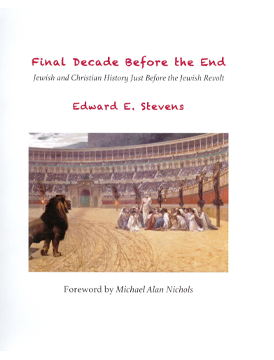One Column Page
and responsive to boot
Chaos in Jerusalem Before the Siege
by Edward E. Stevens
This article appeared in the 2023 Spring issue of Fulfilled! Magazine

In this article we will look at the activities of the Zealots in Jerusalem during the winter (Jan-Mar) of AD 70, just before the Romans began their siege of the city.
After Vespasian was hailed as emperor by his troops and allies in Caesarea and Berytus, he then went up to Antioch (Aug 69), and down to Alexandria (Dec 69) where he heard that Vitellius had died and the Roman Senate had confirmed him as the new emperor [Wars 4:620, 630, 656 (4.10.6; 4.11.1; and 4.11.5)]. His younger son, Domitian, was set up with some limited power to manage Roman affairs until Vespasian arrived in Rome [Wars 4:654 (4.11.4)].
Titus came to Alexandria during the winter while his father was there (Jan-Mar 70). Then when Vespasian departed for Rome in the Spring, he sent Titus from Alexandria “with a select part of his army to destroy Jerusalem” [Wars 4:658-663 (4.11.5)]. Titus gathered his troops at Caesarea “having resolved to set his forces in order at that place before he began the war” [Wars 5:1 (5.1.1)].
Two Zealot Factions Became Three
Gary Goldberg (www.josephus.org) writes that “the chief priests led by Matthias [previous High Priest], the Idumaeans, and the wealthy citizens of Jerusalem decide to overthrow John [of Gischala] by inviting Simon [son of Giora] into the city” (April 69). [Brackets added—EES]
Then in December 69, Eleazar b. Ananias, who controlled the inner temple courts, broke away from John of Gischala [Wars 5.5-8 (5.1.2)]. Eleazar then fortified the walls of the inner courts so that he could defend his position against the other two Zealot factions (led by John and Simon). John held the outer courts and porticos of the temple, while Simon b. Giora held the rest of the city outside the temple area.
Thus, during the winter (Jan-Mar 70) while Vespasian and Titus were in Alexandria, “it so happened that the [Zealot] sedition at Jerusalem was revived, and parted into three factions, and that one faction fought against the other” [Wars 5:2; 5:21 (5.1.1 and 5.1.4)].
The book of Revelation apparently alludes to this: “The great city was split into three parts” (Rev 16:19). And Jesus may have had this in mind when he said that “any city divided against itself will not stand” (Matt 12:25–26; cf. Mark 3:24–25; Luke 11:17–18).
They Destroyed Each Other’s Food Supplies
John’s forces raided other areas of the city that were controlled by Simon, in order to weaken Simon’s fortifications and steal his grain supplies. Any storehouses they could not capture were burned.
This resulted in the destruction of almost all of the grain stored in the city, making it impossible for them to survive the coming siege [Wars 5.21-26 (5.1.4)]. Josephus described this situation as being “like a wild beast grown mad . . . eating its own flesh” [Wars 5.4 (5.1.1)].
Zealots Thought They Were Invincible
They were under the delusion that God would never allow the Temple to be destroyed, and that their Zealot cause would ultimately prevail. That is why each of the three Zealot leaders tried to eliminate the other two [Wars 5:3-6 (5.1.1-2)]. They mistakenly believed that whichever Zealot leader happened to be on top when they conquered the Romans, would be the next ruler of the world.
And just as Jesus had forewarned (cf. Matt 24:11, 24; Mk 13:22), many false prophets were suborned by the tyrants to seduce the Jews into supporting the war effort by promising victory over the Romans [Wars 6:286-288 (6.5.2-3)].
This is how the Romans were already guaranteed success before the siege even began. The Zealots were over-confident about the outcome of the war, and thus weakened themselves at the very time when they should have united and strengthened themselves for the desperate struggle that was about to come.
Blood and Corpses in the Temple and Streets
All three factions used archers to shoot at each other. Simon attacked John, and John attacked Eleazar. John used some of the sacred timbers in the temple to construct towers from which to shoot at Eleazar’s forces on top of the temple [Wars 5.36 (5.1.5)].
The flash point was the Temple, both inside and out. And sadly, there were a lot of non-combatant priests and innocent worshippers killed in the temple during all these attacks. Josephus said that “the blood of all sorts of dead carcasses stood in lakes in the holy courts” [Wars 5.11-20 (5.1.3)]. Human blood in the temple was an abomination [Wars 5.11-20 (5.1.3); cf. Antiq 2:455 (2.17.10); Wars 2:210 (2.11.3); 4:163 (4.3.10)]. This sounds like statements in the Apocalypse (Rev 16:6; 18:24; 19:2).
Yosippon groaned over the horrifying atrocities committed by the Zealot factions in Jerusalem at this time (Jan-Apr 70):
. . . now behold their slain and dead cover the surface of the land, and there is no one who buries, for there is no peace for the buriers because others come and kill them, and they die without a grave . . . And you, Temple of the sanctuary of God . . . [filled] with the carcass of human corpses. You reek from the blood of the slain, your streets are filled with the stabbed and those dead from famine, and your courtyards are filled with dead. [Sepher Yosippon, Ch. 73]
This was the condition of the city during the winter of AD 70 just before Titus came to begin the siege. The Zealots were killing each other in the temple and the streets of Jerusalem, and leaving the corpses unburied.
Two Witnesses Were Killed At This Time
This horrifying situation in Jerusalem provides a very strong clue for nailing down the fulfillment of the Two Witnesses. Revelation 11:3 states that the Two Witnesses prophesied for 1260 days (three and a half years). We do not know when that period began, but we do know that it ended at a time when dead bodies were being left unburied in the streets of Jerusalem. Notice it says that “their dead bodies will lie in the street of the great city” and “they will not permit their dead bodies to be laid in a tomb” (Rev 11:8-9).
There was only one period of time when dead bodies could have lain unburied in Jerusalem, and that was when the three Zealot factions were attacking each other inside the city. And since that kind of abomination was definitely happening during the five months before the siege (from Dec 69 until May 70), it means that the death, resurrection, and ascension of the Two Witnesses most likely occurred during that time before the siege began.
Furthermore, since God has promised to always warn his people before he judged them, it means that the siege could not have begun until those two prophets finished their testimony (Amos 3:7; cf. Isa 48:16; Jer 11:7-10; 19:15; 25:4; 26:5; 35:15; 44:4; 2 Kings 17:13; 2 Chron 24:19; 36:15-16; Zech 7:11-12).
After completing their testimony they were killed, and their bodies lay in the streets of Jerusalem for three and a half days, then came back to life, and ascended into heaven in the sight of their enemies. And since the Zealots did not repent after seeing and hearing all of this, God immediately afterward brought the Roman armies to begin the siege (May of 70).
This seems to pinpoint the end of the Two Witnesses’ testimony in May of 70 – possibly earlier, but no later than that. Counting backward three and a half years from May 70 would take us to November 66, which was right after Cestius Gallus was defeated, and the Zealot leaders gathered in Jerusalem to form their new government and appoint regional commanders for the coming war with Rome. This was probably when the Two Witnesses began their warnings to repent and stop the rebellion.
It is significant that the Two Witnesses performed the same kind of signs as Moses and Elijah (Rev 11:6). That may be a clue to their identity. So, it is extremely interesting when we hear Yosippon at that very time calling upon Moses, Elisha, and other prophets to awake out of Sheol and intervene on behalf of the Jewish people [Sepher Yosippon, Ch. 73]. And he mentions three priests and prophets who were killed by the Zealots and left in the streets without burial (Anani [Ananus II], Yehoshua, and Zechariah). That might be worth some more research.
However, if Moses and Elijah did appear in Jerusalem at this time, it would not have been to help the Zealots, but rather to warn them to repent or face the swift and certain wrath of God. That is evidently what happened. Rather than heed the warnings of the Two Witnesses, they killed two more prophets in Jerusalem – thus filling up the cup of wrath to overflowing, just as Jesus had repeatedly warned them (Matt 23:32-39; Luke 11:47-51; 13:33-35; Rev 18:24). Immediately their troubles spiraled out of control, and Titus surrounded Jerusalem to begin the siege. That is where we will begin next time.
For more info about the Two Witnesses, email a request for the article: The Two Witnesses. The following resources might also be helpful:
Historical podcasts: www.buzzsprout.com/11633
Historical book, Final Decade Before the End, available at our webstore: www.preterist.org/product-cat/all/
Comments:
Your honest review will help others in their search for truth. If you must leave a negative review please be gracious.
Rather, speaking the truth in love, we are to grow up in every way into him who the head, into Christ . . . .
(Ephesians 4:15)
We have migrated to "Disqus" commenting software. Older comments (if any) are archived below, but any new comments on this page will be handled by Disqus. If you are not familiar with "Disqus," click here for more information. You don't need a Disqus account to post comments, however, without an account you won't be notified if someone responds to your post.
Archived Comments:
 Fulfilled
Fulfilled